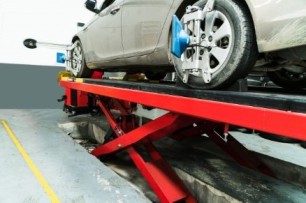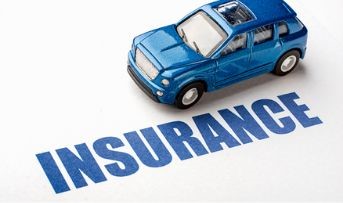General Insurance Blogs, Articles & Updates by - Magma HDI
Have us call you
- RENEW YOUR POLICY
- BUY NEW POLICY

Know more about the wheel alignment of your car and how to check it by yourself
To be a vehicle owner entails a variety of duties. To get the most out of your automobile, you must frequently care for and repair it. If sufficient care is not performed, not only will your vehicle's quality suffer, but it may also cause an accident. Having your vehicle's tyres aligned regularly is one of the most important things you need to ensure tyres last longer.
Many individuals believe that alignment should be left to specialists. While this is true in many ways, some alignment specifications are simple enough to check on your own, and wheel alignment is one of them. This may be useful after upgrading steering or suspension parts so that the car isn't out of alignment during the journey to the shop, or it can at the very least offer a better knowledge of the process.
Following are a few ways you can check your car's wheel alignment by yourself.
1. Caster:
Most vehicles are constructed with a mild downward caster. Your caster angle contributes to the equilibrium of driving, balance, and turning. A high caster causes the steering axis to lean toward the driver. On the other hand, a low caster indicates that your vehicle's steering axis is tilted away from the driver.
To measure the caster angle yourself, you need to park the vehicle on a flat surface and place both wheels on the turntables. Next, install the bubble gauge on the hub. Then turn the tyre 20 degrees inwards and level the gauge. Using the adjustment knob, set the caster reading as zero. Now, move the tyre 20 degrees outwards to get the caster reading.
2. Camber:
Camber is the degree of tyre lean of a car measured in degrees. Negative camber takes place when the top of the tyre tilts inwards. Whereas positive camber occurs when the top of the tyre tilts outwards.
Most contemporary automobiles feature a somewhat negative camber to increase stability and control. Camber misalignment may be caused by worn bearing, ball joints, and other wheel suspension systems. Excessive inward or outward skew indicates poor alignment and must be corrected.
3. Toe-in:
Toe alignment, as opposed to camber alignment, is the degree to which your tyres spin inward or outward as seen from up top. Depending on the vehicle, typical toe-in standards range from one-thirty-second to one-eighth-inch. Toe-in alignment occurs when your automobile's tyres are inclined in the same direction. Toe alignments are done at the last after caster and camber are done.
As a vehicle owner, you must recognise the signs of misaligned wheels. Take a moment to check your vehicle's wheel alignment regularly. It can add to the life of your car's tyres and improve the handling. Even if you decide to get the vehicle aligned in a garage, you will better understand the issue and information.
As needed, trained and experienced vehicle experts will be able to align your wheels. However, to sustain the absolute protection of your vehicle, yourself, and anyone around you, it is advisable to opt for insurance. If you have just purchased a new car, always remember to buy new car insurance to safeguard your vehicle.
Click HERE to buy new car insurance.
Disclaimer: The information provided above is for illustrative purposes only. To get more details, please refer to policy wordings and prospectus before purchasing a policy.

Let's know if proportionate deduction resolves all your confusion surrounding sub-limits in health insurance
Health insurance consists of myriad terms and conditions that policyholders should read in detail at the time of health insurance policy renewal or purchasing. However, most of us usually do not pay heed to them and suffer at the time of settlement of the claim. An important clause involves sub-limits in a health insurance policy and the subsequent proportionate deduction.
Sub-limits in health insurance policies usually include capping or limiting the room rent during your hospitalisation. There are a variety of rooms available in any hospital, ranging from general wards to semi-private rooms and deluxe rooms. There is also a proportionate deduction clause associated with the sub-limit. Let us understand these terms in detail.
Sub-limits explained.
Sub-limits are limits or maximum percentage of the total sum insured that an insurance company will bear for the hospital expenses under various categories. Insurance companies usually use the maximum permissible room rent in the hospital as a benchmark for deciding the sub-limits.
For example, if your health insurance policy is Rs.5 lakhs and the permissible sub-limit for room rent is 1%, the insurance company will only bear 1% of Rs.5 lakhs or Rs.5000 per day for the rent of your room in the hospital. Any amount over it will have to be borne by you.
In this case, if your room rent is Rs.7000 per day, the excess amount of Rs.2000 over the sub-limit cap of Rs.5000 per day will have to be borne by you. Generally, the sub-limit on room rent ranges between 1%-2% of the total insured amount.
Proportionate deductible clause.
Insurance companies usually insert a proportionate deductible clause in health insurance policies. The companies calculate the excess room rent over the sub-limit allowed in percentage terms. They then deduct a proportional amount from all associated treatment costs, including surgery fees, tests, doctor consultation and visiting charges, ICU charges, etc. The insured has to bear them from his pocket.
Insurance companies use the following formula to calculate the proportionate deduction.
Excess room rent over the room rent limit/ Room rent limit as per the policy x 100
For example, suppose the room rent limit per the policy is Rs.5000 per day, and the actual room rent is Rs.7000 per day. Hence, proportionate deduction to be applied:
2000/5000 x 100 = 40%
In this case, if the doctor consultation fee is Rs.2000, the insurance company will deduct 40% of this amount, i.e., Rs.800, and will cover only Rs.1200. The remaining Rs.800 will have to be borne out of your pocket.
How to deal with the proportionate deductible clause?
You should always check whether the proportionate deductible clause applies to your health insurance policy when purchasing it. If applicable, you should adhere to the sub-limit cap and choose a room accordingly in the hospital, especially if your hospitalisation period exceeds 3-4 days. This will ensure that the insurance company cannot apply the proportionate deductible clause and will cover all expenses during the hospitalisation period.
If your policy includes a sub-limit capping, consider changing your insurer at the time of health insurance policy renewal to one without such a clause. We can also port our policy to some other company for this purpose.
A health insurance policy is fundamental in the present world because of our food habits and lifestyle. However, only some people know the concept of sub-limit capping and proportionate deductible clauses. This can burn a big hole in your pocket in a medical emergency.
Do not worry if your health insurance policy comes with these riders. Shift to another policy or company at the time of health insurance policy renewal. This will protect you while ensuring that the insurance company will bear all the hospital expenditures in case of hospitalisation.
Click HERE to purchase reliable health insurance.
Disclaimer: The information provided above is for illustrative purposes only. To get more details, please refer to policy wordings and prospectus before purchasing a policy.

Know more about these motorcycle classes: BS4 and BS6
Are you looking to purchase your first two-wheeler or perhaps on the hunt for an upgrade to your current one? You must have heard various terms such as BS6 and BS4 being used for two-wheelers. Before we jump into understanding them, let's understand why we are talking about these classes.
In order to address the growing concerns about pollution and global warming, the Government of India has introduced regulations known as Bharat Stage Emission Standards (BSES). BSES is the governing body responsible for regulating the output of air pollutants coming out from vehicles. The BSES has made it mandatory for all motorcycle producing brands to register and primarily sell only BS6 bikes from 1st April 2020.
In this blog, we will try to bring forth everything there is to know about BS4 and BS6 engines.
What are BS4 and BS6?
BS4 and BS6 are the 4th and the 6th iteration of the BSES pollution regulations. The Central Pollution Control Board put forth the BS4 emission norms in 2017, which permitted 50 parts per million sulphur content. However, with the introduction of BS6, it was mandated that only ten parts per million Sulphur content were allowed.
Due to BS6, India's emission norms are believed to be equivalent to those of developed countries. BS6 means cleaner fuel and less toxic gases from the exhaust, thus reducing the pollutant content in the air.
The BS6 petrol engine is 25 per cent cleaner than the BS4 motor. And in the case of diesel, it is 80 per cent cleaner than a BS4 diesel engine.
Can you use BS6 fuel in a BS4 vehicle?
BS6 vehicles aren't everywhere just yet, so most motorcycles using BS6 fuel are BS4 vehicles. The important thing to keep in mind is that it is a cleaner fuel and will be perfectly fine for your engine.
Once the laws are mandated, every fuel station will be pumping BS6 fuel. So it is unreasonable to expect one to change their vehicle. This is why it is acceptable to use BS6 power in your BS4 vehicles.
Can you use BS4 fuel in a BS6 vehicle?
It is highly unlikely to have any immediate effect on the motorcycle. There has been certain ambiguity when it comes to this. The petrol engine manufacturers said no effects were seen when a BS6 vehicle used BS4 fuel. However, in the case of diesel engines, there will be some wear and tear eventually. Though, the repercussions would be seen over a very long period.
With the constantly changing time and increasing pollution and population, the automobile industry is preparing for revolutionary changes in the next five to ten years. The laws concerning pollution are becoming more stringent, and it is essential to keep your bike's health in top order to avoid hefty fines in future. Regular check-ups, including pollution checks and servicing, are vital for the good health of your two-wheeler.
It is a good idea to purchase bike insurance to protect yourself from any expenses incurred during these processes. Invest in the bike insurance plan that comes with an attractive premium and features to benefit you when in need.
Click HERE to check out bike insurance plans.
Disclaimer: The information provided above is for illustrative purposes only. To get more details, please refer to policy wordings and prospectus before purchasing a policy.

Infrequent drivers, check out pay-as-you-drive insurance
Car insurance services are evolving to serve their customers more efficiently and effectively. With the advancement of technology, car insurance has moved from paper-based to digital-based insurance offerings. One such evolution in car insurance is introducing pay-as-you-drive insurance.
If you've never heard of the term, here's all you need to know!
What is pay-as-you-drive insurance?
The pay-as-you-drive insurance model is a new car insurance policy recently introduced in India. It allows the policyholder to customise their car insurance and reduce the premium. The required third-party liability car insurance is included in the pay-as-you-drive insurance for the length of the policy. Apart from that, it provides comprehensive coverage based on the distance the car travels. Policyholders of pay-as-you-drive insurance pay the premium for the distance their car covers.
There is no need to worry about the authentication of pay-as-you-drive insurance, as the Insurance Regulatory and Development Authority of India (IRDAI) has approved this insurance mode. Therefore, some car insurance companies in India offer and accept the pay-as-you-drive insurance model. This insurance is an excellent option for infrequent drivers. So, if you take out your car occasionally, this insurance is an advantage for you!
How does pay-as-you-drive car insurance work?
As mentioned above, pay-as-you-drive is new in India, and only some people are aware of the rules and regulations of this insurance policy. To make things easier, we have mentioned some essential points for a better understanding.
1. Research a little about the insurance company:
Only some insurance companies are offering the pay-as-you-drive insurance mode. Thus, it is essential to look for genuine sellers. Conduct basic online research about those who offer this plan. Once you've found a genuine insurer, you'll need this feature to move forward with the insurance policy along with
● Recent odometer reading and other essential car details
● Consent form
● Necessary KYC details
● Driving licence
Besides these, provide other documents requested by the insurance company.
2. Deciding the kilometres:
Unlike other types of car insurance, the premium for a pay-as-you-drive policy is determined by the number of kilometres driven by your car. While choosing the policy, you must make an informed decision on how far you wish to drive your vehicle since you'll have to pay the insurance premium according to the distance your car covers. Be sure to check and read all the terms and conditions before finalising.
3. Installation of the telematics device:
As your insurance company may have told you, you may need to put a telematics device in your vehicle. The telematics devices help record the kilometres driven by your car. You can easily install the application on your smartphone and keep a record of how much total distance you have covered.
The insurance company can also use this application to remind you about the exhaustion of the chosen kilometre slab. They can also inform you about easy top-up and renewal notifications.
In addition to tracking how far a car has gone, the device provides information about average speed, how the brakes are used, etc. With all this information, the premium is calculated by analysing the collected data.
Initially, purchasing such a new insurance policy may seem risky. Over time, you'll realise that it is an excellent way to protect your car if you're an infrequent driver. Research more about the pay-as-you-drive insurance policy and consider purchasing the policy from the best car insurance company in India to ensure complete protection for your car.
Click HERE to buy car insurance to safeguard your car from mishaps.
Disclaimer: The information provided above is for illustrative purposes only. To get more details, please refer to policy wordings and prospectus before purchasing a policy.

Snake bite: Seven immediate actions you need to take
No matter how prepared you are or how well planned your life is, there is always something that catches you by surprise. You could be out on a trek, visiting a wildlife sanctuary, or just simply walking in your garden when you spot a snake, and while your first instinct may be to run, it is said that snakes do not attack unless they feel threatened.
So staying calm and avoiding movement might be the best option you have. However, if you find yourself in a situation involving a snake bite, these are the few things that you could follow to ensure your or the victim's safety.
1. Staying calm:
This might seem like a banal comment during emergencies, but staying calm ensures that your heart is not pumping blood vigorously. Panicking leads to faster circulation, which means it will spread the venom.
2. Restrict movement:
This step is crucial, as the passage of the venom is not directly associated with blood flow. The venom flows through your lymph, which only moves when you do. So any calls that you need to make for the ambulance should be done by somebody else.
3. Pressure immobilization:
Bandage firmly, 'above' the area of the bite. Use a piece of cloth if a bandage is not available. Roll it around the lymph till whatever place it can reach. Now splint the affected area to keep it still. Use any stick, rolled-up layers of paper, etc., to support.
4. Do not wash the wound:
Washing the area gets rid of the venom that the doctors can use to identify the species of snake. Therefore, it is advised to leave the affected area as-is for the benefit of the doctors.
5. Rush to the nearest hospital:
The only remedy to a venomous snake bite is to get an anti-venom as soon as possible. Rush to the nearest medical facility to ensure that timely medication is provided before the patient's condition turns critical.
6. Keep the victim warm:
It is crucial to keep the patient warm and calm to keep their blood pressure under control. However, no caffeine or alcohol should be given. In addition, any food or beverage, including water, should not be provided since it will slow their metabolism.
7. No ice packs and self-medication:
Research shows that using an ice pack on snake bites is harmful and can add to your problems. Avoid the inspection and cleaning of the wound, and avoid using medicines that you might use for regular cuts and wounds. Don't take any action without proper knowledge. The hospital staff are trained to attend to the wound, the venom, and the medication for every circumstance.
Sticking to the steps mentioned above will buy the patient some time before the anti-venom can be injected. As mentioned, a snake bite can create a sense of panic and fear, but maintaining your calm and taking the first aid measures ensures that you have sufficient time before reaching the doctor or medical facility.
Life is full of surprises, some good and some bad. Being prepared always helps, which is why you should invest in good health insurance. With a plethora of options available in the market, you can sit back and not worry about the unnecessary expenses you might face in case of such emergencies.
Click HERE to find out more about health insurance plans that you can invest in.
Disclaimer: The information provided above is for illustrative purposes only. To get more details, please refer to policy wordings and prospectus before purchasing a policy.

Incentives for policyholders may encourage safe driving on roads
The number of vehicles on Indian roads is witnessing an ever-increasing trend. This graph simultaneously shows a sharp rise in online motor insurance policyholders. This is primarily due to the increase in the disposable incomes of families and the changing lifestyle. However, this has also resulted in a drastic increase in road accidents and road rage cases.
It is the need of the hour to promote safe driving on the roads so that people feel protected while using the streets. Providing various incentives for policyholders by online motor insurance companies may encourage safe driving on the roads. Let us see how.
1. Telematics:
Driver telematics is gaining popularity and is an important tool to study and alter irresponsible driver behaviour on the roads. It can also be used as a data analysis tool to provide insights into driving behaviour and reward or penalise a driver.
Telematics in insurance can be app-based or black-box based. It can be useful in tracking driver behaviour, speed, acceleration style, clutch use, braking pattern, etc. Motor insurers can develop a point-based system and reward safe driving on roads with positive points. This means you will be rewarded with positive points if you maintain a good average speed, do not jump traffic signals, and are not involved in any accidents.
On the other hand, you can be penalised by providing negative points if you overspeed, jump traffic signals, or indulge in rash driving and accidents.
The drivers with positive points at the end of the insurance term get a discount on their renewal premium as an incentive. Drivers with net negative points at the end of the year will be charged a higher premium as a punishment. This can provide drivers, especially beginners, a great incentive to drive safely and responsibly to lower their premiums.
2. No-claim Bonus:
Most online motor insurance companies already provide a no-claim bonus or NCB to incentivise safe driving under a comprehensive car insurance policy. You get discounts of up to 50% of the insurance premium at the time of renewal if you have yet to make any claim throughout the year.
NCB is a great incentive for policyholders to encourage safe driving on roads. It encourages driving responsibly and safely, thereby preventing accidents. NCB ranges from a 20% discount in the first year of renewal to 50% for the fifth or higher claim-free year.
3. Damages and dents:
Motor insurance companies can provide incentives such as discounts on renewal premiums to the drivers to keep their cars free from scratches, external damages, and dents. They can check for such external damages during insurance renewal and reward the customers with minimal or nil external damage. This will motivate the drivers to drive safely on the roads so that they do not engage in any collision or accident with other vehicles or property.
Providing incentives for policyholders to encourage safe driving on the roads is paramount and the need of the hour. The number of accidents and loss of lives and property due to them will decrease significantly. Moreover, this will benefit online motor insurance companies, as safe driving will mean fewer claims resulting in higher profits.
Online motor insurance companies highlight the incentives they plan to provide on their websites and all the portals providing online motor insurance services. Potential policy buyers should go through these incentives and policy details to choose the best online motor insurance policy. Irrespective of the incentives and benefits, drivers must always have the mindset of safe driving.
Click HERE to buy online motor insurance.
Disclaimer: The information provided above is for illustrative purposes only. To get more details, please refer to policy wordings and prospectus before purchasing a policy.

Let's understand the difference between fuel injection and carburettor in bikes
Buying a bike is a significant investment for any individual. You put a lot of thought and money into the type of bike you want. The model, budget, brand, features, arrangement of finances are some significant factors a prospective bike owner must consider while making a decision.
An essential part of finalising the type of bike you want is determining the fueling system: carburettor or fuel injection system. For someone who desires to buy a motorcycle but is not technically sound, determining the difference between these two can be an exhausting process.
In this blog, let's understand the difference between fuel injection and carburettor in bikes so that you can get a clear idea about which one would serve your needs in the best way possible.
Let's have a look at the carburettor:
The carburettor is the traditional fuel-delivery system in two-wheelers. It has been the standard system opted by most manufacturers in India. The carburettor consists of a tube connected to a venturi. The venturi then reduces the fuel's flow by narrowing it into a cone-shaped tube. Air pressure is created by the device developing suction to draw the fuel. In layman's terms, the carburettor combines air and fuel in a definite ratio and passes it on to the combustion chamber.
Why should you opt for a carburettor?
1. They are relatively cheap, resistant and sturdy.
2. Affordable and easily replaceable.
3. Fine-tuning is possible (improves mileage).
4. Easily removable and serviceable.
What are the difficulties you might face?
1. You might experience a lag when you squeeze the throttle while riding.
2. It cannot achieve optimum fuel efficiency.
3. Prone to damage (wear and tear).
4. Dust blockages can be problematic.
Now, let's understand what a fuel injection system is?
A fuel injection system is a modern technology-based system used in bikes in the current times. It consists of multiple electronic components and sensors that form the Electronic Control Unit (ECU), which monitors the whole fuel-injected system. The fuel pump inside the tank monitors and controls the fuel flow. The ECU calculates the air and fuel needed for the combustion process.
What are the advantages?
1. Sharper throttle response with no lag.
2. Precise air and fuel mixture for efficient combustion.
3. Durable and low maintenance process.
4. Better mileage.
5. Reduced air pollution.
What are some hitches of the fuel injection system that you might face?
1. Comparatively expensive than the carburettor system.
2. Difficult to fine-tune without expensive and complex tools.
3. ECU takes a professional understanding of how things work. Regular mechanics might find it challenging to repair.
Those were the significant concepts, advantages and challenges to help you understand the difference between fuel injection and carburettor in bikes. This will help you determine which system would cater to your needs in the best way possible. Now, to make sure that you safeguard your bike during unfortunate incidents, it would be a wise option to get it insured.
Explore the market and buy the best two wheeler insurance online India which suits your needs. Digital technology has made it convenient for customers to purchase insurance of their choice online without any intermediary's involvement.
Click HERE to know more about how you can purchase two wheeler insurance online India.
Disclaimer: The information provided above is for illustrative purposes only. To get more details, please refer to policy wordings and prospectus before purchasing a policy.

Let's understand the merits and demerits of 4-wheel drive cars
Cars are fantastic companions for commutation, whether you're cruising along highways, navigating busy roads, or going off-roading. On the other hand, the technology-driven components of the cars determine their performance in various conditions.
The variety of car features has significantly increased in recent times, and you now have more choices when selecting your next car than ever before. One such option is a four-wheel drive (4WD) car based on the drivetrain system you want to use.
A 4WD offers to maximise the effective usage of the vehicle on rough roads and rocky terrains. It is an exciting concept that has been introduced in the automobile sector but requires good knowledge to utilise it to its best potential.
You need to understand the merits and demerits of 4WD to make the right choice before buying one.
Advantages of 4WD:
1. A widespread myth is that you must always drive your car in 4WD mode. You have the option of switching between 4WD and 2WD at any time. Modern four-wheel-drive automobiles have a button that activates or disengages all four wheels. So, if you don't require all four wheels to work simultaneously, you may drive around with the 2WD system.
2. In hazardous driving situations such as snow, ice, mountain regions, and other scenarios where staying in control is challenging, 4WD enhances traction and control by engaging both sets of wheels.
3. The improved traction gets combined with the engine's enhanced power. It provides the extra boost 4WD vehicles require to climb over obstacles and up steep inclines. It is ideal for off-roading and mountainous terrain.
Disadvantages of 4WD:
1. The most significant downside of 4WD is the increased expense of acquisition, and maintenance. The extra equipment (transfer case, differentials, etc.) increases the vehicle's complexity and weight, increasing its original market value.
2. Furthermore, the additional weight of a 4WD system and the additional power generated result in lower fuel economy than 2WD systems. Driving your automobile with all four wheels producing power will burn more fuel.
3. Drivers that employ 4WD may grow overconfident, leading to more situations where they become stuck. Excessive confidence can even lead to dangerous accidents if the driver loses control over the vehicle and fails to manage the power that is being generated.
4. The 4WD system connects the front and back driveshafts, ensuring that all four wheels revolve at the same speed. It makes it harder to turn the car because the wheels must move at different rates to corner successfully. The inner wheel rotates slower than the outer wheel, which must traverse a greater distance in the same amount of time. As a result, the outer wheel will rotate quicker. You will damage the transfer case, gears, and drive shafts if you turn the car with 4WD activated. Hence, it's best to use 4WD only for off-roading.
A 4WD is a fantastic investment if you enjoy driving off-road or if you have to deal with difficult driving conditions regularly. But don't assume you need 4WD to get to and from work.
Whether it is a 2WD or 4WD, securing your car from damages is paramount. Accidents are unpredictable, but safety can be defined beforehand. Buy car insurance policy online to stay financially shielded and protect your car to get the best returns on your investment.
Click HERE to buy car insurance policy online.
Disclaimer: The information provided above is for illustrative purposes only. To get more details, please refer to policy wordings and prospectus before purchasing a policy.


